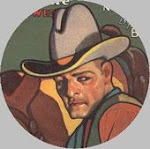
A book I illustrated, The Bleeding Horse and Other Ghost Stories, has recently been named winner of the Children of the Night Award by the Dracula Society.
The Bleeding Horse is the name of a pub. No animals were harmed during the making of this book.
I must admit, this book is not a western. Although Dublin is noted for its long history in keeping Western civilization alive.
The book was published by Mercier Press in Ireland.
The author, Brian J. Showers, is a native of Madison, Wisconsin, who lives in Dublin, Ireland. The dust jacket painting is by noted fantasy artist, Scott Hampton. I provided the black-and-white pen-and-ink interior illustrations, one of which I've included with this post. Three stories from The Bleeding Horse, "Favourite No. 7 Omnibus", "Quis Separabit" and "Father Corrigan's Diary", received honorable mentions by fantasy and horror anthologist Ellen Datlow in her Best Horror of the Year (2008) listing.
The stories blend fact and imagination about a series of actual sites along the Rathmines Road, which runs through Rathmines, a Dublin neighborhood that Showers now calls home. Showers' creativity in melding truth with fiction lends a verisimilitude that leaves the reader wondering if these stories are really true.
THE BLEEDING HORSE is available through Amazon.com at http://www.amazon.com/Bleeding-Horse-Other-Ghost-Stories/dp/1856355780/ref=sr_1_1?ie=UTF8&s=books&qid=1255538196&sr=1-1/thepulprack-20. If you purchase it through that link, I earn a few pennies.
Brian and I have collaborated on other works, including Literary Walking Tours of Gothic Dublin, a nonfictional look at the lives and haunts of three famed Dublin ghost story writers -- including Dracula author Bram Stoker -- and a story by each, illustrated by me. It was published by Nonsuch Ireland in 2006. Gothic Dublin is available through Amazon.com at http://www.amazon.com/Literary-Walking-Tours-Gothic-Dublin/dp/1845885236/ref=sr_1_1?ie=UTF8&s=books&qid=1255538246&sr=1-1/thepulprack-20.
We also have worked on hand-crafted chapbooks published by Brian through his Swan River Press. More information about those books are available at Brian's web site, http://www.brianjshowers.com/.







